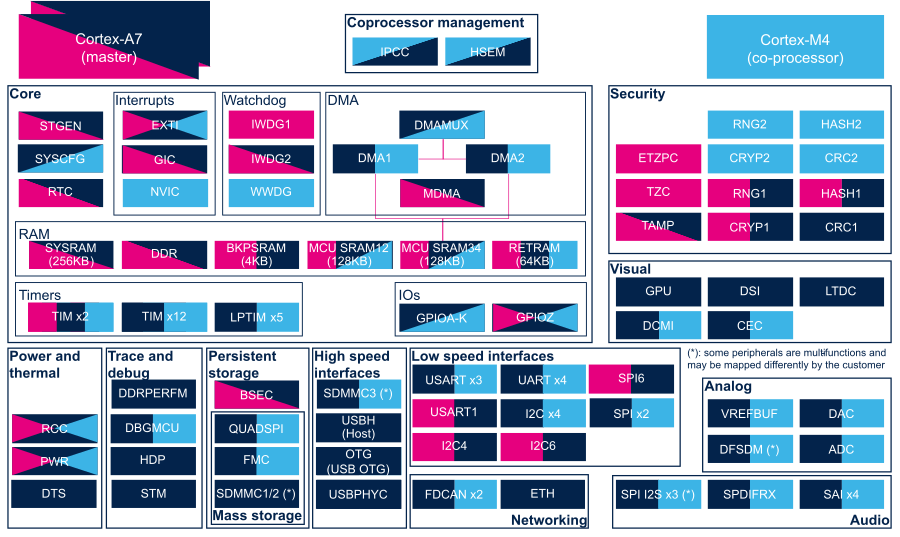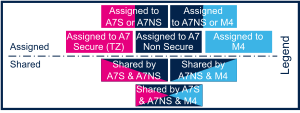This article lists all internal peripherals embedded in STM32MP15 device and shows the assignment possibilities to the runtime contexts for each one of them.
Via this article, you can also access to individual peripheral articles in which information related to the overview and configuration can be found.
1. Internal peripherals overview[edit source]
The figure below shows all peripherals embedded in STM32MP15 device, grouped per functional domains that are reused in many places of this wiki to structure the articles.
Several runtime contexts exist on STM32MP15 device[1], corresponding to the different Arm cores and associated security modes:
- Arm dual core Cortex-A7 secure (Trustzone), running a Secure Monitor or Secure OS like OP-TEE
- Arm dual core Cortex-A7 non secure , running Linux
- Arm Cortex-M4 (non-secure), running STM32Cube
Some peripherals can be strictly assigned to one runtime context: this is the case for most of the peripherals, like USART or I2C.
Other ones can be shared between several runtime contexts: this is the case for system peripherals, like PWR or RCC.
The legend below shows how assigned and shared peripherals are identified in the assignment diagram that follows:
Both the diagram below and the following summary table (in Internal peripherals assignment chapter below) are clickable in order to jump to each peripheral overview articles and get more detailed information (like software frameworks used to control them). They list STMicroelectronics recommendations. The STM32MP15 reference manual [2] may expose more possibilities than what is shown here.


- STGEN
- SYSCFG
- RTC
- EXTI
- GIC
- NVIC
- IWDG
- WWDG
- DMA
- DMAMUX
- MDMA
- SYSRAM
- DDR via DDR CTRL
- BKPSRAM
- MCU SRAM
- RETRAM
- TIM
- LPTIM
- GPIO
- IPCC
- HSEM
- RCC
- PWR
- DTS
- DDRPERFM
- DBGMCU
- HDP
- STM
- BSEC
- QUADSPI
- FMC
- SDMMC
- FDCAN
- ETH
- USBH
- OTG
- USBPHYC
- USART
- I2C
- SPI
- RNG
- HASH
- ETZPC
- CRYP
- CRC
- TZC
- TAMP
- GPU
- DSI
- LTDC
- DCMI
- CEC
- VREFBUF
- DAC
- DFSDM
- ADC
- SPI I2S
- SPDIFRX
- SAI
2. Internal peripherals assignment[edit source]
Click on the right to expand the legend...
| Domain | Peripheral | Runtime allocation | Comment | |||
|---|---|---|---|---|---|---|
| Instance | Cortex-A7 secure (OP-TEE) |
Cortex-A7 non-secure (Linux) |
Cortex-M4 (STM32Cube) | |||
| Analog | ADC | ADC | ☐ | ☐ | Assignment (single choice) | |
| Analog | DAC | DAC | ☐ | ☐ | Assignment (single choice) | |
| Analog | DFSDM | DFSDM | ☐ | ☐ | Assignment (single choice) | |
| Analog | VREFBUF | VREFBUF | ☐ | Assignment (single choice) | ||
| Audio | SAI | SAI1 | ☐ | ☐ | Assignment (single choice) | |
| SAI2 | ☐ | ☐ | Assignment (single choice) | |||
| SAI3 | ☐ | ☐ | Assignment (single choice) | |||
| SAI4 | ☐ | ☐ | Assignment (single choice) | |||
| Audio | SPDIFRX | SPDIFRX | ☐ | ☐ | Assignment (single choice) | |
| Coprocessor | IPCC | IPCC | ☑ | ☑ | Shared (none or both) | |
| Coprocessor | HSEM | HSEM | ✓ | ✓ | ✓ | |
| Core | RTC | RTC | ✓ | ✓ | RTC is mandatory to resynchronize STGEN after exiting low-power modes. | |
| Core | STGEN | STGEN | ✓ | ✓ | ||
| Core | SYSCFG | SYSCFG | ✓ | ✓ | ||
| Core/DMA | DMA | DMA1 | ☐ | ☐ | Assignment (single choice) | |
| DMA2 | ☐ | ☐ | Assignment (single choice) | |||
| Core/DMA | DMAMUX | DMAMUX | ☐ | ☐ | Shareable (multiple choices supported) | |
| Core/DMA | MDMA | MDMA | ☐ | ☐ | Shareable (multiple choices supported) | |
| Core/Interrupts | EXTI | EXTI | ✓ | ✓ | Shared | |
| Core/Interrupts | GIC | GIC | ✓ | ✓ | ||
| Core/Interrupts | NVIC | NVIC | ✓ | |||
| Core/IOs | GPIO | GPIOA-K | ☐ | ☐ | Shareable (with pin granularity) | |
| GPIOZ | ☐ | ☐ | ☐ | Shareable (with pin granularity) | ||
| Core/RAM | BKPSRAM | BKPSRAM | ☐ | ☐ | Assignment (single choice) | |
| Core/RAM | DDR via DDRCTRL | DDR | ✓ | ✓ | ||
| Core/RAM | MCU SRAM | SRAM1 | ☐ | ☐ | ☐ | Assignment (between A7 S and A7 NS / M4) Shareable (between A7 NS and M4) |
| SRAM2 | ☐ | ☐ | ☐ | Assignment (between A7 S and A7 NS / M4) Shareable (between A7 NS and M4) | ||
| SRAM3 | ☐ | ☐ | ☐ | Assignment (between A7 S and A7 NS / M4) Shareable (between A7 NS and M4) | ||
| SRAM4 | ☐ | ☐ | ☐ | Assignment (between A7 S and A7 NS / M4) Shareable (between A7 NS and M4) | ||
| Core/RAM | RETRAM | RETRAM | ☐ | ☐ | ☐ | Assignment (single choice) |
| Core/RAM | SYSRAM | SYSRAM | ☐ | ☐ | Shareable (multiple choices supported) | |
| Core/Timers | LPTIM | LPTIM1 | ☐ | ☐ | Assignment (single choice) | |
| LPTIM2 | ☐ | ☐ | Assignment (single choice) | |||
| LPTIM3 | ☐ | ☐ | Assignment (single choice) | |||
| LPTIM4 | ☐ | ☐ | Assignment (single choice) | |||
| LPTIM5 | ☐ | ☐ | Assignment (single choice) | |||
| Core/Timers | TIM | TIM1 (APB2 group) | ☐ | ☐ | Assignment (single choice) | |
| TIM2 (APB1 group) | ☐ | ☐ | Assignment (single choice) | |||
| TIM3 (APB1 group) | ☐ | ☐ | Assignment (single choice) | |||
| TIM4 (APB1 group) | ☐ | ☐ | Assignment (single choice) | |||
| TIM5 (APB1 group) | ☐ | ☐ | Assignment (single choice) | |||
| TIM6 (APB1 group) | ☐ | ☐ | Assignment (single choice) | |||
| TIM7 (APB1 group) | ☐ | ☐ | Assignment (single choice) | |||
| TIM8 (APB2 group) | ☐ | ☐ | Assignment (single choice) | |||
| TIM12 (APB1 group) | ☐ | ☐ | ☐ | Assignment (single choice) TIM12 or TIM15 can be used for HSI/CSI calibration[3] | ||
| TIM13 (APB1 group) | ☐ | ☐ | Assignment (single choice) | |||
| TIM14 (APB1 group) | ☐ | ☐ | Assignment (single choice) | |||
| TIM15 (APB2 group) | ☐ | ☐ | ☐ | Assignment (single choice) TIM12 or TIM15 can be used for HSI/CSI calibration[3] | ||
| TIM16 (APB2 group) | ☐ | ☐ | Assignment (single choice) | |||
| TIM17 (APB2 group) | ☐ | ☐ | Assignment (single choice) | |||
| Core/Watchdog | IWDG | IWDG1 | ☐ | |||
| IWDG2 | ☐ | ☐ | Shared (none or both):
| |||
| Core/Watchdog | WWDG | WWDG | ☐ | |||
| High speed interface | OTG (USB OTG) | OTG (USB OTG) | ☐ | |||
| High speed interface | USBH (USB Host) | USBH (USB Host) | ☐ | |||
| High speed interface | USBPHYC (USB HS PHY controller) | USBPHYC (USB HS PHY controller) | ☐ | |||
| Low speed interface | I2C | I2C1 | ☐ | ☐ | Assignment (single choice) | |
| I2C2 | ☐ | ☐ | Assignment (single choice) | |||
| I2C3 | ☐ | ☐ | Assignment (single choice) | |||
| I2C4 | ☐ | ☐ | Assignment (single choice). Used for PMIC control on ST boards. | |||
| I2C5 | ☐ | ☐ | Assignment (single choice) | |||
| I2C6 | ☐ | ☐ | Assignment (single choice) | |||
| Low speed interface or audio |
SPI | SPI2S1 | ☐ | ☐ | Assignment (single choice) | |
| SPI2S2 | ☐ | ☐ | Assignment (single choice) | |||
| SPI2S3 | ☐ | ☐ | Assignment (single choice) | |||
| SPI4 | ☐ | ☐ | Assignment (single choice) | |||
| SPI5 | ☐ | ☐ | Assignment (single choice) | |||
| SPI6 | ⬚ | ☐ | Assignment (single choice) | |||
| Low speed interface | USART | USART1 | ☐ | ☐ | Assignment (single choice) | |
| USART2 | ☐ | ☐ | Assignment (single choice) | |||
| USART3 | ☐ | ☐ | Assignment (single choice) | |||
| UART4 | ☐ | ☐ | Assignment (single choice). Used for Linux® serial console on ST boards. | |||
| UART5 | ☐ | ☐ | Assignment (single choice) | |||
| USART6 | ☐ | ☐ | Assignment (single choice) | |||
| UART7 | ☐ | ☐ | Assignment (single choice) | |||
| UART8 | ☐ | ☐ | Assignment (single choice) | |||
| Mass storage | FMC | FMC | ☐ | ☐ | Assignment (single choice) | |
| Mass storage | QUADSPI | QUADSPI | ☐ | ☐ | Assignment (single choice) | |
| Mass storage | SDMMC | SDMMC1 | ☐ | |||
| SDMMC2 | ☐ | |||||
| SDMMC3 | ☐ | ☐ | Assignment (single choice) | |||
| Networking | ETH | ETH | ☐ | Assignment (single choice) | ||
| Networking | FDCAN | FDCAN1 | ☐ | ☐ | Assignment (single choice) | |
| FDCAN2 | ☐ | ☐ | Assignment (single choice) | |||
| Power & Thermal | DTS | DTS | ☐ | |||
| Power & Thermal | PWR | PWR | ✓ | ✓ | ✓ | |
| Power & Thermal | RCC | RCC | ✓ | ✓ | ✓ | |
| Security | BSEC | BSEC | ✓ | ✓ | ||
| Security | CRC | CRC1 | ☐ | |||
| CRC2 | ☐ | |||||
| Security | CRYP | CRYP1 | ☐ | ☐ | Assignment (single choice) | |
| CRYP2 | ☐ | |||||
| Security | ETZPC | ETZPC | ✓ | ✓ | ✓ | |
| Security | HASH | HASH1 | ☐ | ☐ | Assignment (single choice) | |
| HASH2 | ☐ | |||||
| Security | RNG | RNG1 | ☐ | ☐ | Assignment (single choice) | |
| RNG2 | ☐ | |||||
| Security | TZC | TZC | ✓ | |||
| Security | TAMP | TAMP | ✓ | ✓ | ||
| Trace & Debug | DBGMCU | DBGMCU | No assignment | |||
| Trace & Debug | DDRPERFM | DDRPERFM | ✓ | |||
| Trace & Debug | HDP | HDP | ☐ | |||
| Trace & Debug | ETM | ETM0 | ✓ | ✓ | ||
| ETM1 | ✓ | ✓ | ||||
| Trace & Debug | STM | STM | No assignment possible | |||
| Visual | CEC | CEC | ☐ | ☐ | Assignment (single choice) | |
| Visual | DCMI | DCMI | ☐ | ☐ | Assignment (single choice) | |
| Visual | DSI | DSI | ☐ | |||
| Visual | GPU | GPU | ☐ | |||
| Visual | LTDC | LTDC | ☐ | |||
3. References[edit source]

